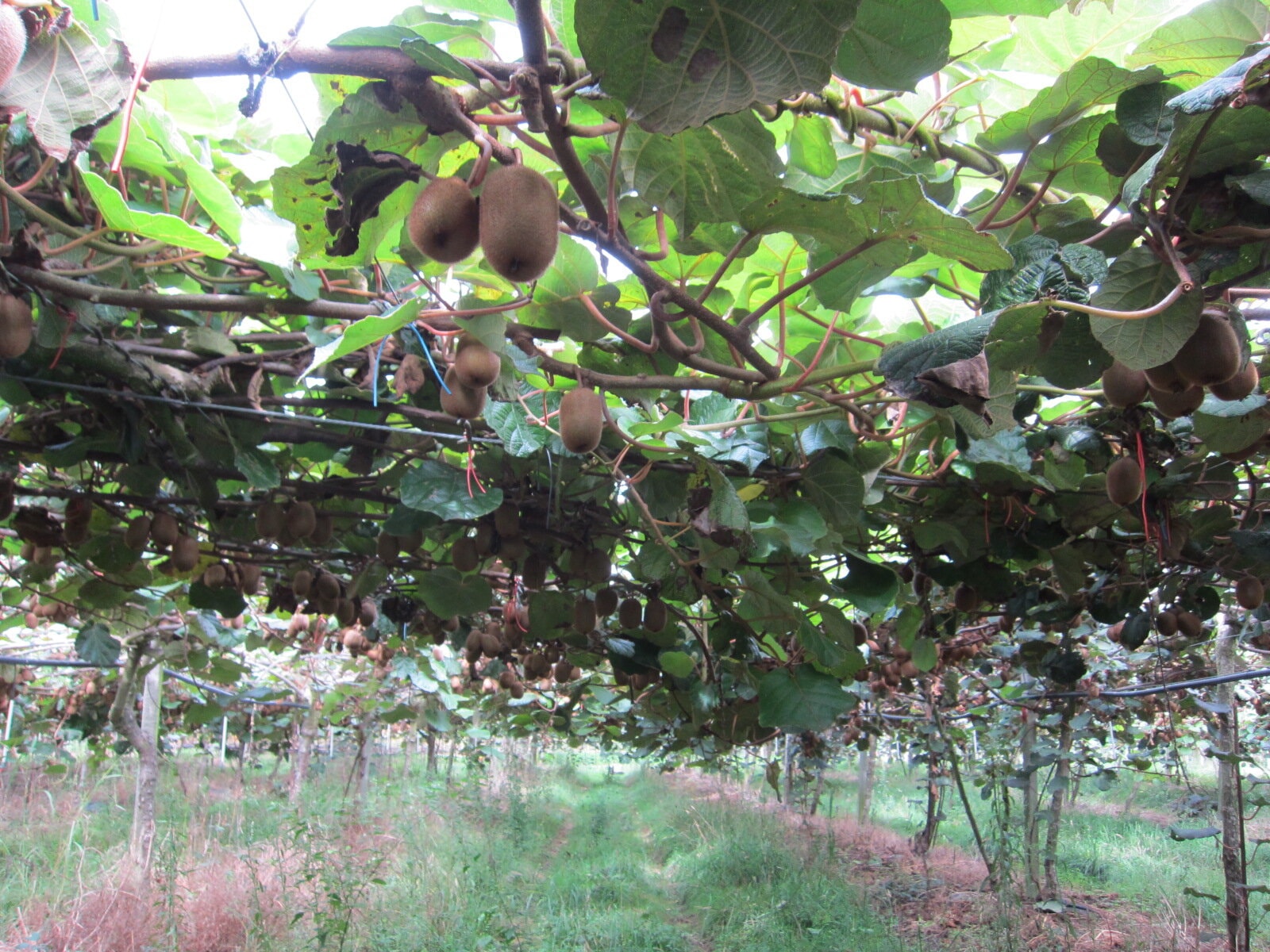Polinização Artificial no Kiwi - Bibliografia
Texto de: Helena Castro, Catarina Siopa, Vinícius Casais, Mariana Castro, João Loureiro, Hugo Gaspar, Sílvia Castro
Universidade de Coimbra, Centro de Ecologia Funcional, Departamento de Ciências da Vida
A polinização tem um papel essencial na produção de muitas culturas, incluindo o kiwi. No entanto, este é um fator pouco compreendido no contexto da gestão agrícola do pomar. A limitação de pólen e os seus impactos na produção são influenciados por fatores tais como o grau de dependência de polinizadores, a diversidade e abundância da comunidade de polinizadores, os habitats circundantes e as condições climatéricas no momento da floração. Conhecer estas condicionantes no pomar é essencial para avaliar se a polinização é ótima ou se existe necessidade de ser melhorada. Em algumas culturas, como o kiwi, pode ser necessário recorrer à polinização artificial para suprir a falta de pólen e/ ou insuficiência da polinização natural. Neste estudo, foi avaliada a melhoria na produtividade resultante da aplicação artificial de pólen e a eficiência das técnicas usadas na produção e ganho monetário em sete pomares distribuídos pela principal área de produção de kiwi em Portugal. Para tal, a produção dos pomares foi quantificada: 1) em condições de polinização natural, 2) após a aplicação mecânica de pólen, e 3) após aplicação suplementar manual de pólen. Os resultados mostram que a suplementação com pólen melhorou a produção na maior parte dos pomares, por aumentar a formação de frutos e/ou o seu peso, o que influencia a distribuição pelos diferentes calibres. No entanto, a polinização mecânica nem sempre foi eficiente e/ou necessária.

BIBLIOGRAFIA
Antunes, M.D.C., Oliveira, M., Teixeira, M., Veloso, A., Veloso, F., Panagopoulos, T., 2007. Evaluation of the effect of complementary pollination on actinidia deliciosa “Hayward” in northwest Portugal. Acta Hortic. 753, 347–352. https://doi.org/10.17660/ActaHortic.2007.753.43
Bates, D., Mächler, M., 2015. Package ‘ lme4 ’: Linear mixed-effects models using eigen and S4. J. Stat. Softw.
Castro, H., Siopa, C., Casais, V., Castro, M., Loureiro, J., Gaspar, H., Dias, M.C., Castro, S., 2021. Spatiotemporal variation in pollination deficits in an insect‐pollinated dioecious crop. Plants 10. https://doi.org/10.3390/plants10071273
Castro, H., Siopa, C., Casais, V., Castro, M., Loureiro, J., Gaspar, H., Dias, M.C., Castro, S., 2022. Quantificação dos défices de polinização na cultura do kiwi em Portugal. AGROTEC Nº43, 56-60.
Core Development Team, R., 2016. A language and environment for statistical computing. Vienna: R Foundation for Statistical Computing.
Donati, I., Cellini, A., Buriani, G., Mauri, S., Kay, C., Tacconi, G., Spinelli, F., 2018. Pathways of flower infection and pollen-mediated dispersion of Pseudomonas syringae pv. actinidiae, the causal agent of kiwifruit bacterial canker. Hortic. Res. 5. https://doi.org/10.1038/s41438-018-0058-6
Evans, L.J., Cutting, B.T., Jochym, M., Janke, M.A., Felman, C., Cross, S., Jacob, M., Goodwin, M., 2019. Netted crop covers reduce honeybee foraging activity and colony strength in a mass flowering crop. Ecol. Evol. 9, 5708–5719. https://doi.org/10.1002/ece3.5154
Fox, J., Weisberg, S., 2019. An R Companion to Applied Regression, Third edit. ed. Sage, Thousand Oaks CA.
Garcia, E., Moura, L., Abelleira, A., Aguín, O., Ares, A., Mansilla, P., 2018. Characterization of Pseudomonas syringae pv. actinidiae biovar 3 on kiwifruit in north-west Portugal. J. Appl. Microbiol. 125, 1147–1161. https://doi.org/10.1111/jam.13943
Garibaldi, L.A., Carvalheiro, L.G., Leonhardt, S.D., Aizen, M.A., Blaauw, B.R., Isaacs, R., Kuhlmann, M., Kleijn, D., Klein, A.M., Kremen, C., Morandin, L., Scheper, J., Winfree, R., 2014. From research to action: Enhancing crop yield through wild pollinators. Front. Ecol. Environ. 12, 439–447. https://doi.org/10.1890/130330
Gaspar H, Loureiro J, Castro H, Siopa C, Castro M, Casais V, Castro S (2022) Impact of local practices and landscape on the diversity and abundance of pollinators in an insect-dependent crop. Agriculture, Ecosystems & Environment 326: 107804. https://doi.org/10.1016/j.agee.2021.107804
Gonzalez, M. V, Coque, M., Herrero, M., 1998. Influence of pollination systems on fruit set and fruit quality in kiwifruit (Actinidia deliciosa). Ann. Appl. Biol. 132, 349–355. https://doi.org/10.1111/j.1744-7348.1998.tb05210.x
Goodwin, R.M., McBrydie, H.M., 2013. Use of pollen blowers and pollen dispensers to pollinate kiwifruit artificially. A report prepared for: Zespri Group Ltd.
Hothorn, T., Bretz, F., Westfall, P., 2008. Simultaneous inference in general parametric models. Biometrical J. 50, 346–363. https://doi.org/10.1002/bimj.200810425
Larson, B.M.H., Barrett, S.C.H., 2000. A comparative analysis of pollen limitation in flowering plants. Biol. J. Linn. Soc. Linn. Soc. 69, 503–520.
McPherson, H.G., Hall, A.J., Stanley, C.J., 1994. Seasonal and regional variation in budbreak and flowering of kiwifruit vines in new zealand. New Zeal. J. Crop Hortic. Sci. 22, 264–276. https://doi.org/10.1080/01140671.1994.9513835
Miñarro, M., Twizell, K.W., 2015. Pollination services provided by wild insects to kiwifruit (Actinidia deliciosa). Apidologie 46, 276–285. https://doi.org/10.1007/s13592-014-0321-2
Oliveira, M., Veloso, A., Teixeira, M., Veloso, F., Antunes, D., 2009. Avaliação do efeito da polinização complementar em actinídea deliciosa CV . “ Hayward ” na Região de Entre – Douro e Minho, in: Ramos, A., Martins, J.M.S. (Eds.), I Simpósium Nacional de Fruticultura. Associação Portuguesa de Horticultura, pp. 97–101.
Pérez‐Méndez, N., Andersson, G.K.S., Requier, F., Hipólito, J., Aizen, M.A., Morales, C.L., García, N., Gennari, G.P., Garibaldi, L.A., 2020. The economic cost of losing native pollinator species for orchard production. J. Appl. Ecol. 57, 599–608. https://doi.org/10.1111/1365-2664.13561
Razeto, B., Reginato, G., Larraín, A., 2005. Hand and Machine Pollination of Kiwifruit. Int. J. Fruit Sci. 5, 37–44. https://doi.org/10.1300/J492v05n02_05
Rollin, O., Garibaldi, L.A., 2019. Impacts of honeybee density on crop yield: A meta-analysis. J. Appl. Ecol. 56, 1152–1163. https://doi.org/10.1111/1365-2664.13355
Tacconi, G., Michelotti, V., 2018. Artificial Pollination in Kiwifruit and Olive Trees, in: Segneanu, A.E., Orbeci, C., Lazau, C., Sfirloaga, P., Vlazan, P., Bandas, C., Grozescu, I. (Eds.), Pollination in Plants. InTech, p. 29. https://doi.org/10.5772/intechopen.74831
Tacconi, G., Michelotti, V., Cacioppo, O., Vittone, G., 2016. Kiwifruit pollination: The interaction between pollen quality, pollination systems and flowering stage. J. Berry Res. 6, 417–426. https://doi.org/10.3233/JBR-160138
Testolin, R., Vizzotio, G., Costa, G., 1991. Kiwifruit pollination by wind and insects in Italy. New Zeal. J. Crop Hortic. Sci. 19, 381–384. https://doi.org/10.1080/01140671.1991.10422880